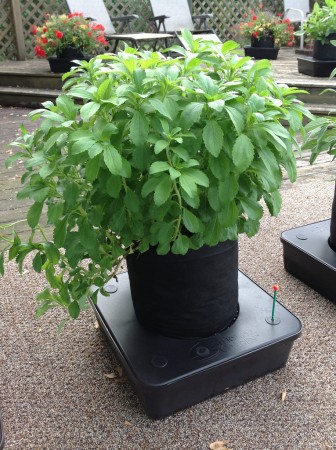How Self-Watering Planters Work
December 22nd, 2013Self-watering planters are a boon to many gardeners and have taken the gardening industry by storm in a variety of forms. Either for people who lack the room to garden in the ground, or people who lack the time for regular watering, they work great. But, how do they work, and could you make one yourself?
Do you remember the word capillary action from school? Or perhaps just wicking? This is why if you dip a piece of paper in water, the water will climb the paper. It also works with soil, and this principle is behind self-watering containers.
Essentially you have two containers in one, the lower container is a water reservoir holding potentially gallons of water, the upper container holds your soil, and it has to specifically be potting mix, regular old dirt doesn’t wick water nearly as well (nor is it good for containers anyways, always use potting mix in containers). There is a mesh connection between the two allowing some soil to get wet. Eventually your plant’s roots will reach the water, but until then the soil will wick moisture up to them. Depending on the size of your reservoir (which also needs an overflow hole so as to not get too wet) you could go weeks without watering. You can also hook a series of containers up to a rain barrel for automatic watering. A container garden that takes care of itself. To add water to the reservoir there is often a pipe or a hole for easy access. You don’t pour water through the soil to reach it, you have direct access to the reservoir.
There are however some downsides to self watering containers. Some plants do not like perpetually damp soil, the soil in a self watering pot will never completely dry out and so those plants may not be happy. Also, depending on how it is designed, there can be an issue with providing mosquitoes an ideal breeding ground (you really need to find one with some sort of cap over the reservoir access and overflow opening). When using a self watering container you directly water the roots, not the foliage so you lose out on opportunities for foliar feeding, however by keeping the leaves dry you also reduce the risk of fungal infections.

Octopot Self Watering Container
There are many types of self watering containers you can buy, but most work on this same concept. One I have is slightly different though. The Octopot uses a special bag made out of wicking fiber. I think this is a superior construction because it pulls water from the reservoir all the way up the sides of the soil, resulting in better moisture coverage in my opinion. With caps over all the ports it also is no friend to mosquitoes and includes a little water level indicator so you can easily see if it needs more water or not. One downside of it is that it is nearly impossible to move when full of water, 6 gallons plus soil is quite heavy, so either pick a spot and stick to it, or put it on a little plant dolly (little square with 4 caster wheels on it, so you can roll your containers around).
The Octopot is obviously utilitarian in appearance and so lends itself more to functional, ie edible, gardening, than ornamentals. However there are some very attractive self watering containers out there as well if you wanted something more presentable for the front walk that you could put flowers in.
You can also make your own. You simply need two plastic containers of roughly equal size. Recycling is best so think of what you use frequently. Do you get those big plastic pails of kitty litter? Ice melt salt? Do you have old 5 gallon buckets from Home Depot lying around? all could be used, though wash them out good if they were used to store yucky things. If you know someone in the food industry you may have access to old used vats of food grade plastic that once held salad dressing or something, that’d be great, you just need two of the same size that can be nested inside each other.
The bottom one you cut a hole in the side 4-6 inches up to act as an overflow, the top one you cut a hole in the bottom and line it with some sort of perforated material, then another hole in which you insert a pipe that leads to the top above the rim. Then you simply fill with soil. It won’t have the fancier features of the Octopot, but it’d get the job done. Here is a photo tutorial on building large ones out of plastic storage containers.

December 30th, 2013 at 5:56 am
I found a lot of interesting and useful information on your blog,so I just wanted to say thank you.
January 17th, 2014 at 7:41 pm
I never thought of this, great idea. Will try soon. Tons of ice melt bags sitting around anyway.
January 31st, 2014 at 8:02 am
Are there any issues with the water becoming stagnant?